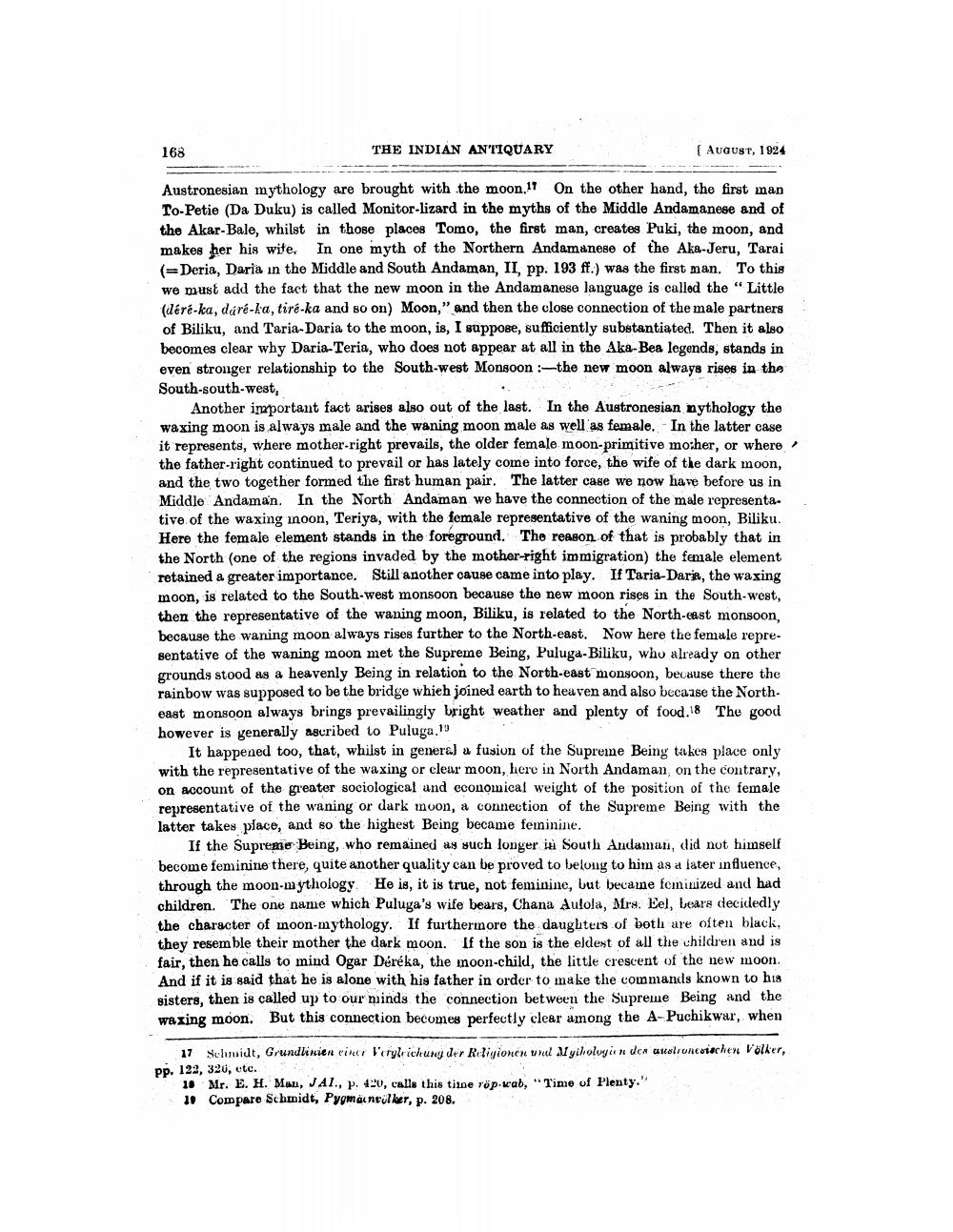________________
168
THE INDIAN ANTIQUARY
(AUGUST, 1924
Austronesian mythology are brought with the moon.17 On the other hand, the first man To-Petie (Da Duku) is called Monitor-lizard in the myths of the Middle Andamanese and of the Akar-Bale, whilst in those places Tomo, the first man, creates Puki, the moon, and makes her his wite. In one myth of the Northern Andamanese of the Aka-Jeru, Tarai (=Deria, Daria in the Middle and South Andaman, II, pp. 193 ff.) was the first man. To this we must add the fact that the new moon in the Andamanese language is called the "Little (déré-ka, dáré-ka, tiré-ka and so on) Moon," and then the close connection of the male partners of Biliku, and Taria- Daria to the moon, is, I suppose, sufficiently substantiated. Then it also becomes clear why Daria-Teria, who does not appear at all in the Aka-Bea legends, stands in even stronger relationship to the South-west Monsoon :the new moon always rises in the South-south-west,
Another important fact arises also out of the last. In the Austronesian nythology the waxing moon is always male and the waning moon male as well as female. In the latter case it represents, where mother-right prevails, the older female moon-primitive mother, or where the father-right continued to prevail or has lately come into force, the wife of the dark moon, and the two together formed the first human pair. The latter case we now have before us in Middle Andaman. In the North Andaman we have the connection of the male representa. tive of the waxing inoon, Teriya, with the female representative of the waning moon, Biliku. Here the female element stands in the foreground. The reason of that is probably that in the North (one of the regions invaded by the mother-right immigration) the female element retained a greater importance. Still another cause came into play. If Taria-Daria, the waxing moon, is related to the South-west monsoon because the new moon rises in the South-west, then the representative of the waning moon, Biliku, is related to the North-east monsoon. because the waning moon always rises further to the North-east. Now here the female representative of the waning moon met the Supreme Being, Puluga-Biliku, who already on other grounds stood as a heavenly Being in relation to the North-east monsoon, because there the rainbow was supposed to be the bridge whieh joined earth to heaven and also because the North. east monsoon always brings prevailingly bright weather and plenty of food.18 The good however is generally ascribed to Puluga. 19
It happened too, that, whilst in general a fusion of the Supreme Being takes place only with the representative of the waxing or clear moon, here in North Andaman, on the contrary, on account of the greater sociological and economical weight of the position of the female representative of the waning or dark moon, a connection of the Supreme Being with the latter takes place, and so the highest Being became feminine.
If the Supreme Being, who remained as such longer in South Andaman, did not himself become feminine there, quite another quality can be proved to belong to him as a later influence, through the moon-mythology. He is, it is true, not feminine, but became feminized and had children. The one name which Puluga's wife bears, Chana Aulola, Mrs. Eel, beara decidedly the character of moon-mythology. If furthermore the daughters of both are often black, they resemble their mother the dark moon. If the son is the eldest of all the children and is fair, then he calls to mind Ogar Deréka, the moon-child, the little crescent of the new moon. And if it is said that he is alone with his father in order to make the commands known to his sisters, then is called up to our minds the connection between the Supreme Being and the waxing moon. But this connection becomes perfectly clear among the A-Puchikwar, when
17 Schmidt, Grundlinien einer Verylichung der Religionen und Mythologiese den ausls uncstachen Völker, pp. 122, 320, etc.
11 Mr. E. H. Max, JAL., p. 420, calls this tine röp wab, "Time of Plenty." 10 Compare Schmidt, Pygmaintülker, p. 208.




